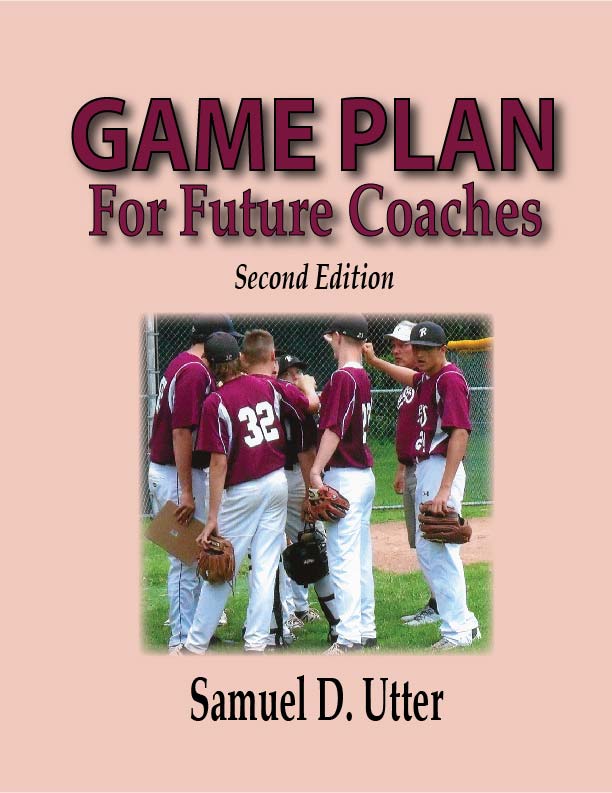Academic, Professional, Technical, Trade, Research Books & Journals
americanpress@flash.net • 617-247-0022 • 75 State Street #100 • Boston, MA 02109
Game Plan for Future Coaches
by SAMUEL D. UTTER
August 2017, 2nd edition, 105 pages, $21.95
ISBN 978-0-89641-567-6
The purpose of this workbook is to guide future coaches through problems, issues, and situations that can occur while they are coaching an athletic team. Coaches who are experienced and successful will tell you that a team's success is not just the "X's and O's". The true success of a team is about the ability to develop character, teach fundamentals, advanced skills of the sport, and develop offensive and defensive game strategies. Another very important aspect of coaching is solving all of the problems, issues and situations that occur when a group of athletes are all striving for personal as well as team success.
Emotional problems, issues and situations affect all athletes and their teammates if they are not taken care of in a firm but fair way. Consistency in decision-making is a very important part of the process. It has been said that a coach has to coach for five seasons before he/she will have a process and procedure to cope with all of the problems, issues and situations that can occur during a season The coach who can handle the problems issues and situations in a firm, fair and consistent way will have a cohesive team that respects you and their fellow teammates. This workbook will help you become aware of the different problems, issues, and situations that can occur during the length of a season. All of these cases are authentic and took place during the author’s 26 years as an Athletic Administrator.
There are six steps in the problem-solving process that every coach should follow when developing different solutions to problems, issues and situations.
Notify your Athletic Administrator of the problem issue or situation and seek his advice.
Gather all the information from both sides of the problem issue or situation. Until you have gathered all of the information from everyone involved, stay neutral in your decision-making.
Develop a list of possible solutions and pick the one solution that best aligns itself with your coaching philosophy, training rules, and the schools code of conduct.
Create a process and procedure for carrying out your solution. Inform your Athletic Administrator of your solution and be very selective as to who else you share your solution with. Always notify the parents of the athlete/athletes involved in the problem, issue or situation and how it will affect their son/daughter. This could be in the form of a meeting with all individuals involved, or a one-on-one discussion. Always have another supportive person present when you are discussing your solution.
Evaluate your solution as to its effectiveness in solving the problem, issue or situation. If your solution is affective write it down for future use. If your solution is not affective, think of other ways to address the problem, issue or situation.
Ask yourself if the problem, issue, or situation could have been prevented. If the answer is yes, decide what you would do differently so the problem, issue, or situation does not occur again.
CONTENTS
- Purpose
- Problem-Solving Techniques
- Definitions of Problems
- Use of Questions
- Questions for Case Studies
CASE STUDIES
Case # 1—The Blaming Team
Case # 2—Athletes Commit Vandalism
Case # 3—The Quarterback
Case # 4—The Undercutting Player
Case # 5—The Administrative Assistant
Case # 6—The Drinking Coach
Case # 7—The Friendly Coach
Case # 8—The Mad Father
Case # 9—Playing Time
Case #10—Starting Line Up for Tennis
Case #11—Injured Players
Case #12—The Pregnant Player
Case #13—Violence at the Hockey Game
Case #14—The Summer fight
Case #15—Junior Prom Blast
Case #16—The Yelling Parents
Case #17—The Abused Athlete
Case #18—10th Grader Moves Up
Case #19—The Cutter
Case #20—Team Injuries
Case #21—The Marijuana Smoker
Case #22—Drug User
Case #23—The Missing Athlete
Case #24—Talented 7th Grade Athlete
Case #25—The Unfriendly Custodian
Case #26—Away Game Transportation
Case #27—The Drained Pool
Case #28—The Brothers
Case #29—The Russian Players
Case #30—The Third Year
Case #31—Superintendent’s Child
Case #32—The Missing Practice Rule
Case #33—The Petition
Case #34—Profane Language
Case #35—Two Adult Siblings
Case #36—Socialite Players
Case #37—It Happens All of the Time
Case #38—The Two Brothers
Case #39—Modified B Soccer Game
Case #40—Poor Team Selection
Case #41—My Son
Case #42—Young Guy soccer Coach
Case #43—Lesbian Cheerleader
Case #44—Hysterical Swimmer
Tribute to a Coach
Appendix: Guided Classroom Field Observation